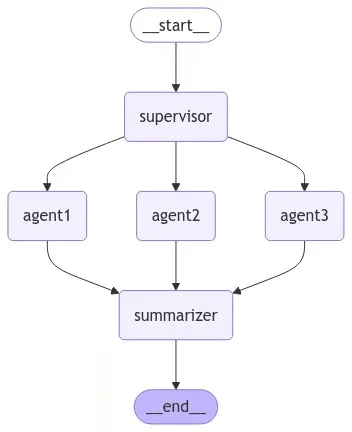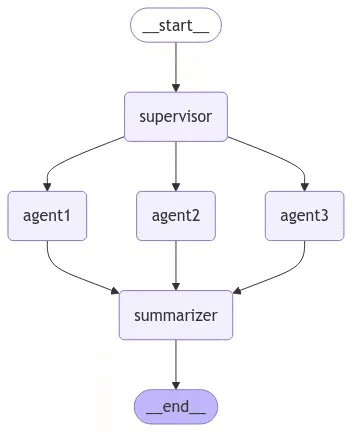探索多LLM代理:提升并行处理与自动摘要效率
2024年09月29日 由 alex 发表
248
0
在工作中,我们经常需要比较多个大型语言模型(LLM)对同一请求的响应。然而,单独执行这些请求可能非常耗时。为了解决这个问题,我们探索了一种使用 LangGraph 的方法,通过单个查询获取多个模型的响应,并利用 LLM 的强大功能自动汇总结果。
实施
我们参考了 LangGraph 的官方文档来实现并行处理。我们使用 Google Colab 作为环境。
我们构建的图的结构如下。我们将从最简单的配置开始:

- 主管负责监督整个流程,并为每个代理分配任务。
- 每个代理执行其分配的任务,并将结果发送给汇总器。
- 汇总器汇总每个代理的结果并生成最终输出。
安装所需软件包
python
%pip install -qU langchain-google-genai
%pip install -qU langchain-anthropic
%pip install -qU langchain-core
%pip install -qU langchain-openai
%pip install -qU tavily-python
%pip install -qU langchain_community
%pip install -qU langgraph
%pip install -qU duckduckgo-search
设置 API 密钥
我们将每个 LLM 提供商(OpenAI、Anthropic、Google、Langsmith)的 API 密钥设置为环境变量。这些都已在 Colab 的 “Secrets ”中预先配置。
import os
from google.colab import userdata
os.environ["ANTHROPIC_API_KEY"] = userdata.get('ANTHROPIC_API_KEY')
os.environ["GOOGLE_API_KEY"] = userdata.get("GOOGLE_API_KEY")
os.environ['OPENAI_API_KEY'] = userdata.get('OPENAI_API_KEY')
os.environ['LANGCHAIN_TRACING_V2'] = userdata.get('LANGCHAIN_TRACING_V2')
os.environ['LANGCHAIN_API_KEY'] = userdata.get('LANGCHAIN_API_KEY')
定义必要的类和类型
import operator
from typing import Annotated, Any, List
from typing_extensions import TypedDict
from langgraph.graph import StateGraph, START, END
from langchain.schema import HumanMessage, AIMessage
from langchain_anthropic import ChatAnthropic
from langchain_google_genai import ChatGoogleGenerativeAI
from langchain_openai import ChatOpenAI
class State(TypedDict):
messages: Annotated[List[str], operator.add]
iteration: int
class Node:
def __init__(self, name: str):
self.name = name
def process(self, state: State) -> dict:
raise NotImplementedError
def __call__(self, state: State) -> dict:
result = self.process(state)
print(f"{self.name}: Processing complete")
return result
实施每个节点
监控节点
管理任务和初始化。
class SupervisorNode(Node):
def __init__(self):
super().__init__("Supervisor")
def process(self, state: State) -> dict:
state['iteration'] = state.get('iteration', 0) + 1
task = state['messages'][0] if state['messages'] else "No task set."
return {"messages": [f"Iteration {state['iteration']}: {task}"]}
代理节点
为每个 LLM 模型执行任务。
class AgentNode(Node):
def __init__(self, agent_name: str, llm):
super().__init__(agent_name)
self.llm = llm
def process(self, state: State) -> dict:
task = state['messages'][-1]
response = self.llm.invoke([HumanMessage(content=f"You are {self.name}. Please execute the following task: {task}")])
return {"messages": [f"{self.name}'s response: {response.content}"]}
汇总器节点
汇总每个代理的响应。
class SummarizerNode(Node):
def __init__(self, llm):
super().__init__("Summarizer")
self.llm = llm
def process(self, state: State) -> dict:
responses = state['messages'][1:] # Skip the initial task
summary_request = "Please summarize the responses from each agent so far.\n" + "\n".join(responses)
response = self.llm.invoke([HumanMessage(content=summary_request)])
return {"messages": [f"Summary: {response.content}"]}
初始化 LLM 模型
def create_llm(model_class, model_name, temperature=0.7):
return model_class(model_name=model_name, temperature=temperature)
# High-performance models
claude = create_llm(ChatAnthropic, "claude-3-5-sonnet-20240620")
gemini = create_llm(ChatGoogleGenerativeAI, "gemini-1.5-pro-002")
openai = create_llm(ChatOpenAI, "gpt-4o")
# Lightweight models
# claude = create_llm(ChatAnthropic, "claude-3-haiku-20240307")
# gemini = create_llm(ChatGoogleGenerativeAI, "gemini-1.5-flash-latest")
# openai = create_llm(ChatOpenAI, "gpt-4o-mini")
构建图表
定义和执行任务
builder = StateGraph(State)
nodes = {
"supervisor": SupervisorNode(),
"agent1": AgentNode("Agent1 (claude)", claude),
"agent2": AgentNode("Agent2 (gemini)", gemini),
"agent3": AgentNode("Agent3 (gpt)", openai),
"summarizer": SummarizerNode(openai)
}
for name, node in nodes.items():
builder.add_node(name, node)
builder.add_edge(START, "supervisor")
for agent in ["agent1", "agent2", "agent3"]:
builder.add_edge("supervisor", agent)
builder.add_edge(agent, "summarizer")
builder.add_edge("summarizer", END)
graph = builder.compile()
结果和说明
执行后,你会得到类似下面的结果:
Supervisor: Processing complete
Agent2 (gemini): Processing complete
Agent3 (gpt): Processing complete
Agent1 (claude): Processing complete
Summarizer: Processing complete
Summary: Here's a summary of each agent's response:
- **Agent1 (claude)**: The marble is inside the refrigerator. They explain that even when the cup was turned upside down, the marble remained inside, and when the cup was moved to the refrigerator, the marble went with it.
- **Agent2 (gemini)**: The marble is on the table. They explain that when the cup was turned upside down, the marble fell onto the table, and it remained there even after the cup was moved to the refrigerator.
- **Agent3 (gpt)**: The marble is inside the refrigerator. Their reasoning is similar to Agent1's, stating that the marble stayed in the cup when it was turned upside down and was then moved to the refrigerator with the cup.
In summary, Agent1 and Agent3 conclude that "the marble is inside the refrigerator," while Agent2 states that "the marble is on the table."
检查图表定义
将图形结构可视化:
from IPython.display import Image, display
display(Image(graph.get_graph().draw_mermaid_png()))
这将显示图形结构的可视化表示。

文章来源:https://medium.com/@astropomeai/multi-ai-agent-parallel-processing-and-automatic-summarization-using-multiple-llms-ad80f410ae21

欢迎关注ATYUN官方公众号
商务合作及内容投稿请联系邮箱:bd@atyun.com
热门企业
热门职位
写评论取消
回复取消






























